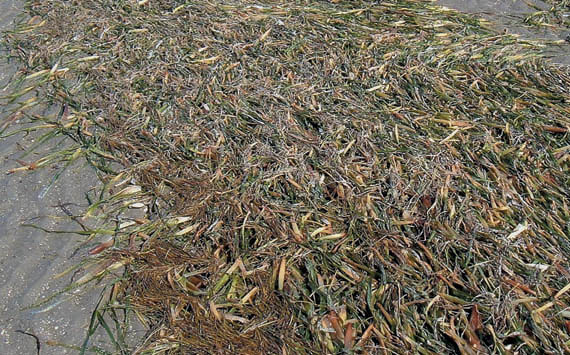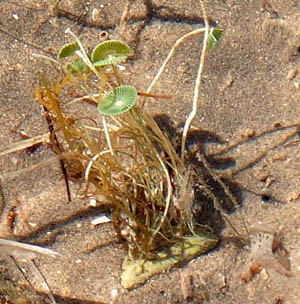
The Saltwater Magazine for Gulf Coast Fishing!
FISHING FORECASTS | FISHING CALENDARS | ARTICLES | SUBSCRIBE
Search Gulf Coast Fisherman's
Web Site
Past articles, specific
places or fish, etc.

by John Hook
Bay Naturalist
- There's More to Seaweed Than You Think

If you're fishing top-waters after the wind has been howling for a few days, none of your adjectives for seaweed can be printed here. On the other hand, we are setting aside whole sections of bays from boat traffic to protect the stuff from getting torn up by outboard props. Is it possible for seaweed to be that bad and that good at the same time? The best response would probably be a definitive maybe.
What we normally call seaweed falls into two very different types of marine vegetation, seagrass and marine algae. Seagrasses are regular plants with roots, leaves and flowers. Yeah, underwater flowers are a little strange, but they really do have them. Essentially, they make a living just like their land plant relatives.
A MERMAIDS WINE CUP
 Most of the inshore Gulf has at least one of
the five common species found between Brownsville and Key West. Shoal grass,
manatee grass, turtle grass, clover grass (called paddle grass in Florida)
and widgeon grass are found in different habitats usually determined either
by water depth or salinity and are the focus of our protective efforts.
Most of the inshore Gulf has at least one of
the five common species found between Brownsville and Key West. Shoal grass,
manatee grass, turtle grass, clover grass (called paddle grass in Florida)
and widgeon grass are found in different habitats usually determined either
by water depth or salinity and are the focus of our protective efforts.
Unfortunately, he type of seaweed that we are protecting is the same stuff that forms massive wind blown mats across the bay. When it keeps fouling your trebles it's hard to appreciate the fact that it's also the reason that we have clear water and that it's a major contributing factor to both fish abundance and diversity.
Bay water clarity is a relative thing. What Galveston Bay fishermen think of as clear wouldn't impress Florida Keys fishermen much and the trick is the amount of seagrass, the more there is the clearer the water. It acts as a sediment trap and sucks nutrients out of the water keeping plankton counts low.
Corals are especially sensitive to cloudy water and that's why lagoons carpeted with turtle, or a similar grass, are almost always found next to coral reefs. Pretty water isn't seaweed's only job. It also transfers carbon and nitrogen into the food chain to form a base for healthy populations of bait and the fish that feed on it.
Seagrass provides cover for many species of larval fish like redfish, trout, snook, tarpon and barracuda, as well as pretty much every species of shrimp and crab. And, there is the obvious connection that turtle and manatee grass have with a couple of endangered species. Additionally, three quarters of the population of redhead ducks winter on the Texas coast and shoal grass is their principle food. You could think of seagrass as the engine that makes a healthy bay run smoothly.
Marine algae are either large (macroalgae) or small (microalgae) and they aren't regular plants. They don't have roots and veins and flowers, but they still are capable of the energy trapping photosynthesis that provides food for everything else as well as converting an unbelievable amount of carbon dioxide into oxygen. The little ones are single celled and are very important in the scheme of things even though we never see the individual organism. They do the bulk of algal photosynthesis, but some of them are the dirty little devils responsible for red and brown tides. The big ones come either as forms that attach themselves to a hard surface or as drift algae. These provide many of the same functions as seagrass, but less effectively.
There is one thing that they do better than seagrasses and that is that some of them are pretty tasty. The seaweed salad at Asian restaurants is nothing other than a collection of several species of macroalgae with salad dressing for $4.95 a serving. You thought some of those looked familiar, right? Several cousins of one of the most common salad ingredients are found all along the Gulf. Since we don't eat the species from them much, they have never gotten a common name. Referred to by their genus; Gracilaria they look just like the curly stemmed green and red items in the salad. Our versions are along the bay bottom wherever seagrass is found and while it can be eaten it isn't as tasty as the cold water forms found in the Asian salad. We also have bright green sea lettuce that grows along jetties primarily, although ours tastes like plastic more than anything else. Cold water species of sea lettuce are considered very good eating as are many other species of macroalgae, but again they are all cold water forms.
The importance of seaweed in productive bay systems is undeniable, even though I have absolutely no trouble cussing it when I can't keep it off my plugs. And it really is a temptation to pull a 360 degree mud spraying exit off the flat instead of drifting for another 15 minutes to water deep enough to not leave a prop scar.
So I guess seaweed really can be that good and that bad all at the same
time.

